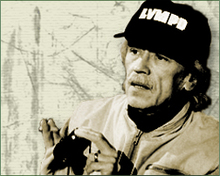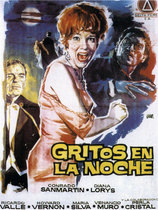Our editor-in-chief Nate Yapp is proud to have contributed to the new book Hidden Horror: A Celebration of 101 Underrated and Overlooked Fright Flicks, edited by Aaron Christensen. Another contributors include Anthony Timpone, B.J. Colangelo, Dave Alexander, Classic-Horror.com's own Robert C. Ring and John W. Bowen. Pick up a copy today from Amazon.com!
John Carpenter
In 1978, one film lit up the horror genre and became the most successful independent production ever (until The Blair Witch Project, anyway). That movie was Halloween, directed by John Carpenter. Carpenter drew his inspirations from the Howard Hawks movies he grew up on, but his output was wholly his own, for better or worse.
Carpenter was raised in Bowling Green, Kentucky. His father was a musician who occasionally played back-up for such artists as Roy Orbison and Brenda Lee. Carpenter himself intended on pursuing music, but his love of cinema drew him elsewhere.
He attended the University of Southern California as a film major. While there, he produced a short film that he would later expand into the theatrical feature Dark Star (1974). Dark Star dealt with the crew of a spacecraft tasked with destroying "unstable planets." The ragtag bunch are slowly succumbing to space psychosis and on top of that, have to deal with a "smart bomb" with potentially explosive personal issues. In addition to producing, directing, and co-writing the screenplay (with Dan O'Bannon), Carpenter also composed the score -- something he would do for most of his theatrical features.
Based on the modest success of Dark Star, Carpenter was then given carte blanche to produce any project he wanted (within a certain budget). He wrote and directed Assault on Precinct 13 (1976), an urban remake of Hawks' Rio Bravo, with some conceptual elements borrowed from George Romero's Night of the Living Dead. Assault also marked the beginning of his collaboration with Debra Hill, who acted as co-editor and script supervisor on this film, but who would play the important role of producer on his next three films.
Halloween (1978) was originally called The Babysitter Murders until the decision was made to set it on October 31st. Carpenter and Hill completed the script in three weeks and production itself took just as long. Working with a budget of only three hundred thousand dollars, Carpenter crafted a chilling tale about a gawky teenage girl (Jamie Lee Curtis) stalked by a mask-wearing murderer. Halloween benefits as much from what it doesn't show as much as from what it does. Carpenter grabs the viewer with a very basic storyline stretched taut, and then throws in scares based on nothing but air. The critically lauded sense of suspense is bolstered by a minimalist synthesizer score that still signals terror whenever it is played. The film eventually took in over 50 million dollars, writing Carpenter's ticket for the next decade.
Carpenter followed Halloween with the television movies Someone's Watching Me (1978) and Elvis (1979). Then, AVCO Embassy signed him to a two-picture deal. His first film under that deal was The Fog.
The Fog (1980) originally began as Carpenter's effort to tell a purely supernatural tale of an almost sentient mist that sought revenge against a sleepy California town for the crimes of its ancestors. Starring Adrienne Barbeau, Tom Atkins, Janet Leigh, Hal Holbrook, and Jamie Lee Curtis, it certainly doesn't lack for talented actors. However, in editing the picture, Carpenter found that it lacked punch. He had to go back and reshoot large chunks of it, bolstering the fog with ghost-zombies wielding sharp hooks and blades. The finished product is a serviceable thriller, but is filled with one-note characters -- a problem that would plague much of Carpenter's subsequent work.
After filming his second film for AVCO, the science fiction actioner Escape from New York (1981), and writing/producing a sequel to Halloween, Carpenter parted ways with Hill and tackled what was to become his favorite of his own films, The Thing (1982). The film was inspired by the Hawks-produced 1951 film, but took most of its material from the original source story "Who Goes There?" by John Campbell, Jr. Instead of battling an alien vegetable that is clearly an external force, Carpenter brought the beast inside. It lives inside your friends, as your friends and nothing can stop it. Unfortunately, Carpenter's predilection for gruff, stubborn "men who are men" kills a sense of character identification and by the second half, the film is little more than a showcase for Rob Bottin's incredible alien effects. A few scenes, however, have taken on almost iconic proportions, including the famous "blood testing" sequence.
The Thing was a box office bomb, unfortunately fighting against such powerhouses as E.T. and Rocky III, not to mention poor critical reviews. Carpenter worked on a what was at the time regarded as a "safe" move for a major horror director in a slump -- a Stephen King adaptation. Christine (1983) follows the exploits of a geek who becomes cool (and something of a jerk) with the help of his sentient, homicidal '58 Plymouth Fury. Carpenter's film is a largely muddled interpretation of King's book; it ignores logical character development in favor of the action and violence. Worsening matters, Carpenter's score is also surprisely anemic. Christine didn't do much better than The Thing from a financial standpoint.
Carpenter spun out two more non-horror films afterwards -- Starman (1984), a tale of alien romance which garnered a Best Actor nomination for Jeff Bridges, and Big Trouble in Little China (1986), a goofball chop-socky fantasy adventure starring Kurt Russell. Carpenter then struck out on his own with three million dollars and filmed the Nigel Kneale-inspired Prince of Darkness (1987). Made largely without studio interference, Carpenter's film about the nature of evil is probably the most debated in his oeuvre; those who like it love it and those who do not like it really loathe every frame.
After Prince of Darkness, Carpenter's work becomes largely unnotable. They Live (1988) -- Invasion of the Body Snatchers by way of Reaganomics -- has some interesting ideas that are blunted by a lot of ridiculous action (including a prolonged fistfight in an alley that serves little purpose). Memoirs of an Invisible Man (1992) remains Carpenter's nadir, a hokey Chevy Chase vehicle based on "look what I can do!" humor.
In the Mouth of Madness (1995) is probably Carpenter's best film from the 1990s. A fairly ambitious, atmospheric film that explores Lovecraftian themes better than most Lovecraft films and also takes a gentle poke at the cult of celebrity surrounding such authors as Stephen King, Madness ultimately succumbs to Carpenter's tendency to leave important things like characters underdeveloped. Still, the film manages to create a sense of fright by surrounding the viewer with a logical non-logic that unnerves.
Carpenter followed that with a flat remake of Village of the Damned (1995) and the horror-Western Vampires (1998), which is little more than a vehicle for James Woods' machismo. Carpenter then ventured into space with the ill-received Ghosts of Mars (2001). None of these films were successes financially or critically.
As of this writing, Carpenter has just finished work on his installment for the first season of Showtime's "Masters of Horror," and he's next slated to work on the thriller Psychopath. He is also a producer on Rupert Wainwright's remake of The Fog (2005).
Carpenter's tendency to underserve his characters makes the misses in his career particularly heinous. Going through his filmography can be a bit like stepping through a minefield -- but it's worth every tiptoe just to get to the good stuff. Films like Halloween, The Fog, and In the Mouth of Madness are all testaments to his skill. Carpenter's filmwork may be spotty, but it's hard to deny his ability to create an atmosphere of terror.








